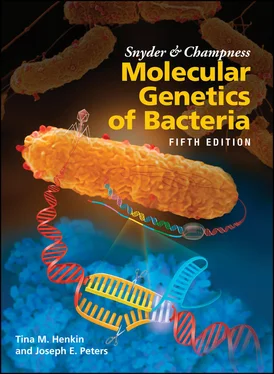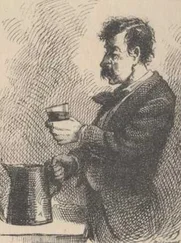Phage strains can be crossed very easily. The same cells are infected with different mutants or strains of the phage. The DNA of the two phages is then in the same cell, where the molecules can interact genetically with each other, allowing genetic manipulations, such as genemapping and allelism tests.
A Brief History of Bacterial Molecular Genetics
Because of the ease with which they can be handled, bacteria and their phages have long been the organisms of choice for understanding basic cellular phenomena, and their contributions to this area of study are enormous. The following chronological list should give a feeling for the breadth of these contributions and the central position that bacteria have occupied in the development of modern molecular genetics. Some original references are given at the end of the chapter under Suggested Reading.
In the early part of the 1900s, biologists agreed that inheritance in higher organisms follows Darwinian principles. According to Charles Darwin, changes in the hereditary properties of organisms occur randomly and are passed on to the progeny. In general, the changes that happen to be beneficial to the organism are more apt to be passed on to subsequent generations.
With the discovery of the molecular basis for heredity, Darwinian evolution now has a strong theoretical foundation. The properties of organisms are determined by the sequence of their DNA, and as the organisms multiply, changes in this sequence sometimes occur randomly and without regard to the organism’s environment. However, if a random change in the DNA happens to be beneficial in the situation in which the organism finds itself, the organism has an improved chance of surviving and reproducing.
As late as the 1940s, many bacteriologists thought that inheritance in bacteria was different from inheritance in other organisms. It was thought that rather than enduring random changes, bacteria could adapt to their environment by some sort of “directed” change and that the adapted organisms could then somehow pass on the change to their offspring. Such opinions were encouraged by the observations of bacteria growing under selective conditions. For example, in the presence of an antibiotic, all the bacteria in the culture soon become resistant to the antibiotic. It seemed as though the resistant bacterial mutants appeared in response to the antibiotic.
One of the first convincing demonstrations that inheritance in bacteria follows Darwinian principles was made in 1943 by Salvador Luria and Max Delbrück (see chapter 3and Suggested Reading). Their work demonstrated that particular phenotypes, in their case resistance to a virus, occur randomly in a growlng population, even in the absence of the virus. By the directed-change or adaptive-mutation hypothesis, the resistant mutants should have appeared only in the presence of the virus.
The demonstration that inheritance in bacteria follows the same principles as inheritance in eukaryotic organisms set the stage for the use of bacteria in studies of basic genetic principles common to all organisms.
As discussed at the beginning of the Introduction, most organisms exhibit some mechanism for exchanging genes. The first demonstration of genetic exchange in bacteria was made by Fred Griffith in 1928. He was studying two variants of pneumococci, now called Streptococcus pneumoniae . One variant formed smooth-appearing colonies on plates and was pathogenic in mice. The other variant formed rough-appearing colonies on plates and did not kill mice. Only live, and not dead, smooth-colony-forming bacteria could cause disease, since the disease requires that the bacteria multiply in the infected mice. However, when Griffith mixed dead smooth-colony formers with live rough-colony formers and injected the mixture into mice, the mice became sick and died. Moreover, he isolated live smooth-colony formers from the dead mice. Apparently, the dead smooth-colony formers were “transforming” some of the live rough-colony formers into the pathogenic, smooth-colony-forming type. The “transforming principle” given off by the dead smooth-colony formers was later shown to be DNA, since addition of purified DNA from the dead smooth-colony formers to the live rough-colony formers in a test tube transformed some members of the rough type to the smooth type (see Avery et al., Suggested Reading). This method of exchange is called transformation (see chapter 6), and this experiment provided the first direct evidence that genes are made of DNA. Later experiments by Alfred Hershey and Martha Chase in 1952 (see Suggested Reading) showed that phage DNA alone is sufficient to direct the synthesis of more phages.
In 1946, Joshua Lederberg and Edward Tatum (see Suggested Reading) discovered a different type of gene exchange in bacteria. When they mixed some strains of E. coli with other strains, they observed the appearance of recombinant types that were unlike either parent. Unlike transformation, which requires only that DNA from one bacterium be added to the other bacterium, this means of gene exchange requires direct contact between two bacteria. It was later shown to be mediated by a genetic element that replicated separately from the chromosome, called a plasmid, in a process that was subsequently called conjugation (see chapter 5).
In 1953, Norton Zinder and Joshua Lederberg (see Suggested Reading) discovered yet a third mechanism of gene transfer between bacteria. They showed that a phage of Salmonella enterica serovar Typhimurium could carry DNA from one bacterium to another. This means of gene exchange is called transduction and is now known to be quite widespread (see chapter 7).
Recombination within Genes
At the same time, experiments with bacteria and phages were also contributing to the view that genes were linear arrays of nucleotides in the DNA. By the early 1950s, recombination had been well demonstrated in higher organisms, including fruit flies. However, recombination was thought to occur only between mutations in different genes and not between mutations in the same gene. This led to the idea that genes were like “beads on a string” and that recombination is possible between the “beads,” or genes, but not within a gene. In 1955, Seymour Benzer disproved this hypothesis by using the power of phage genetics to show that recombination is possible within the r II genes of phage T4. He mapped numerous mutations in the r II genes, thereby demonstrating that genes are linear arrays of mutable sites in the DNA. Later experiments with other phage and bacterial genes showed that the sequence of nucleotides in the DNA directly determines the sequence of amino acids in the protein product of the gene.
Semiconservative DNA Replication
In 1953, James Watson and Francis Crick published their structure of DNA. One of the predictions of this model is that DNA replicates by a semiconservative mechanism, in which specific pairing occurs between the bases in the old and the new DNA strands, thus essentially explaining heredity. In 1958, Matthew Meselson and Frank Stahl used bacteria to confirm that DNA replicates by this semiconservative mechanism.
The existence of mRNA was also first indicated by experiments with bacteria and phages. In 1961, Sydney Brenner, François Jacob, and Matthew Meselson used phage-infected bacteria to show that ribosomes are the site of protein synthesis and confirmed the existence of a “messenger” RNA that carries information from the DNA to the ribosome.
Читать дальше











